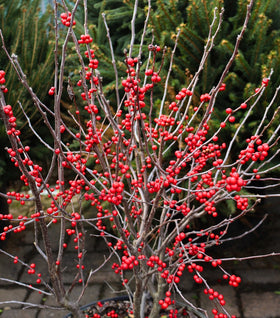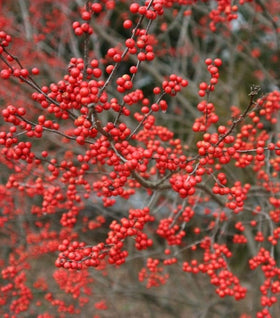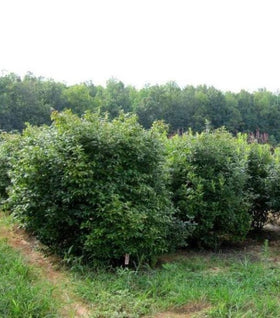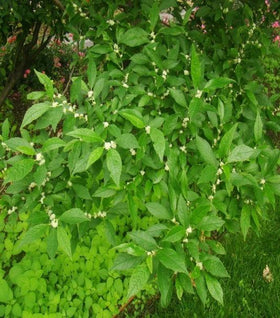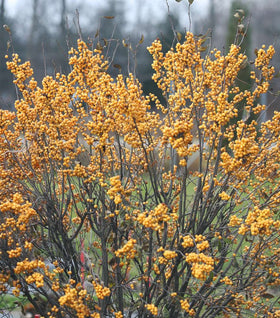Winterberry Holly Shrubs for Sale Online
Winterberry Holly plants, sometimes called Red Winterberry, are beginning to find their way into the American landscape due to the bright red berries that are true standouts in the winter garden. Winterberries are deciduous holly plants, meaning that, unlike other hollies, they lose their leaves in the winter, and this is actually what makes the plants so desirable. When the leaves fall, the real treasure of this plant is exposed. Plump, Bright red berries line the top of the branched stems bringing a truly festive appeal to the landscape.
Using Winterberry in the Landscape
Winterberry or Ilex verticillata is a North American Native shrub typically growing wild around the eastern United States. In the wild, they can reach heights of 10 to 12 feet tall. Like other members of the holly family, they are branches are often used as decorations during the holiday season and can be found sold in bunches. During the spring and summer months, the leaves are dark green. In the spring, small white flowers appear and, if adequately pollinated, will produce a dense crop of berries in late summer and fall. During the summer, the berries are typically hidden by the foliage.
In the fall, the leaves of all varieties turn to a warm golden yellow color and will begin to drop from the plant exposing the gorgeous red berries. The berries will remain on the plant well into the late winter and are a favorite food of songbirds in the early spring before the new leaves appear. The Winterberry is truly an easy-to-grow winter interest shrub.
One of the best ways to show off the berries is to plant them in front of darker green-colored evergreen plants. The evergreens act as a backdrop making the berries pop in the winter garden. Our favorite companion trees for Winterberry Hollies are American Pillar Arborvitae or the Nellie Stevens Holly Tree. Both of these plants produce foliage that is dark enough to make the berries stand out.
A new trend in conservation landscaping has brought winterberries to the spotlight. One of the best ways to use Winterberries is in a rain garden. Those not familiar with Rain Gardens are gardens built into depressions in your yard where water collects after heavy rains. These gardens act as natural filters and allow water to be used by plants that tolerate wet soils like Winterberry hollies.
Read more about How Rain Gardens Benefit your Property
Tips for Successfully growing Winterberry in the Garden
Winterberries grow naturally in full sun through the partial shade in acidic soils. They prefer average garden soils that have consistent moisture levels in the landscape. Winterberries will grow in areas that few other plants will grow in, so don't be afraid to plant them in wet areas of the yard.
Because the flowers and berries appear on new growth each year, winterberry holly plants should be pruned in early spring before the new growth appears. If you decide to cut the branches in the winter for decoration, your pruning is already done for next year. Winterberry branches can be costly to purchase during the holiday season. This is a plant that will pay for itself in money saved during the holidays.
Mulching winterberries is recommended as it is with most shrubs. Since winterberries grow naturally in the woodlands, they are naturally mulched each fall by the falling leaves of trees. Mulching helps keep the soil surrounding the plant evenly moist and keeps the soil temperature from excessively heating up during the hot summer months. Gardeners can mulch with compost, shredded hardwood mulch, or pine needles.
Pine needle mulch will help create an acidic soil in which winterberries thrive. If pine needles are not available in your area of the country, occasionally sprinkle used coffee grounds around the base of the shrub or use a product like Espoma Soil Acidifier to lower the pH of your soil.
Getting the most berries on your Winterberry
You must plant both male and female winterberry plants to get the best berry set on your winterberry hollies. Male plants will never develop berries, so they aren't very showy in the winter. Typically one male Winterberry will pollinate between 5 to 8 female winterberries. The two types can be planted anywhere within about 40 to 50 feet of one another. This allows the showy females to be planted where they can be seen through the year, and the male plant can be planted in a less conspicuous area of the Garden.
Pollinators such as butterflies and honeybees love winterberries and are more than happy to help carry the pollen between the types of plants. The critical caveat to berry production is choosing a male and a female that bloom around the same time, so male pollen is present when the female plants are flowering. Since there are many new cultivars being introduced constantly it's a good idea to review online resources to discover which pollinator is best for the female you are choosing.
The truth is there is much overlap in the bloom times between male pollinators and female berry producers. For instance, Jim Dandy Male Holly blooms about the same time Red Spite and Sparkleberry female hollies. Jim Dandy Male Holly blooms about the same time as Winter Red female holly and therefore is the pollinator of choice.
Our Female Winterberry product pages list the best male pollinator to be used for each variety. Although there are other factors that can affect berry production such as planting the plants in too much shade or pruning the plants too late in the spring if you choose the right male we're confident that by following our suggestions you will have a bumper crop of red berries in your winter garden.
Are Winterberry Hollies Deer Resistant
Winterberry Hollies are considered to be deer-resistant throughout the United States, but if deer become extremely hungry after an extended winter they will occasionally munch on the very tips of the branches. This is seldom seen and there are far more plants that deer will eat before Ilex verticillata.
Do Birds Eat the Red Berries of Winterberry Holly?
Winterberry hollies are a special type of food source for birds. Holly berries are not usually eaten by birds until very late in the winter. This allows the gardener to enjoy the "fruits of their labor" well into the late winter. The reason for this is that holly berries are generally too hard and bitter until they have gone through a few freezes.

